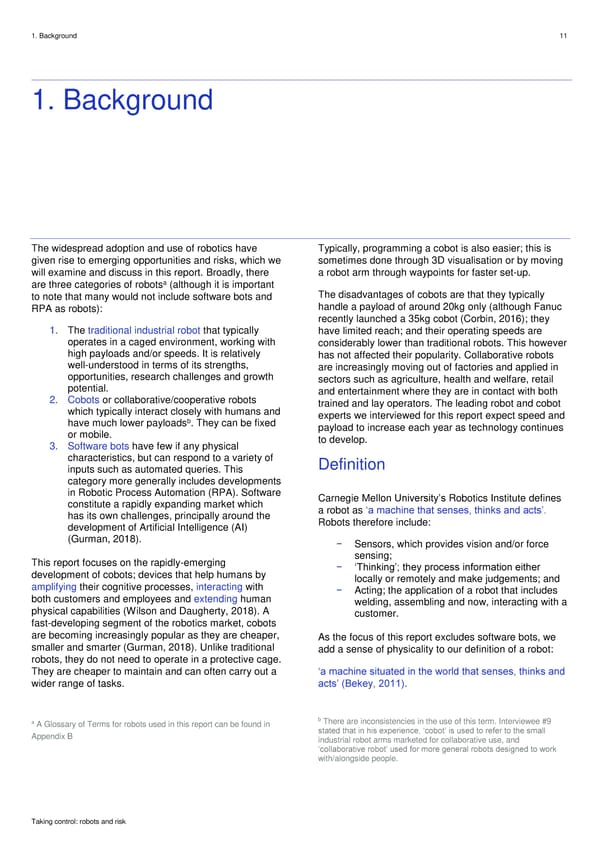1. Background 11 1. Background The widespread adoption and use of robotics have Typically, programming a cobot is also easier; this is given rise to emerging opportunities and risks, which we sometimes done through 3D visualisation or by moving will examine and discuss in this report. Broadly, there a robot arm through waypoints for faster set-up. a are three categories of robots (although it is important The disadvantages of cobots are that they typically to note that many would not include software bots and handle a payload of around 20kg only (although Fanuc RPA as robots): recently launched a 35kg cobot (Corbin, 2016); they 1. The traditional industrial robot that typically have limited reach; and their operating speeds are operates in a caged environment, working with considerably lower than traditional robots. This however high payloads and/or speeds. It is relatively has not affected their popularity. Collaborative robots well-understood in terms of its strengths, are increasingly moving out of factories and applied in opportunities, research challenges and growth sectors such as agriculture, health and welfare, retail potential. and entertainment where they are in contact with both 2. Cobots or collaborative/cooperative robots trained and lay operators. The leading robot and cobot which typically interact closely with humans and experts we interviewed for this report expect speed and b have much lower payloads . They can be fixed payload to increase each year as technology continues or mobile. to develop. 3. Software bots have few if any physical characteristics, but can respond to a variety of Definition inputs such as automated queries. This category more generally includes developments in Robotic Process Automation (RPA). Software Carnegie Mellon University’s Robotics Institute defines constitute a rapidly expanding market which a robot as ‘a machine that senses, thinks and acts’. has its own challenges, principally around the Robots therefore include: development of Artificial Intelligence (AI) (Gurman, 2018). − Sensors, which provides vision and/or force sensing; This report focuses on the rapidly-emerging − ‘Thinking’; they process information either development of cobots; devices that help humans by locally or remotely and make judgements; and amplifying their cognitive processes, interacting with − Acting; the application of a robot that includes both customers and employees and extending human welding, assembling and now, interacting with a physical capabilities (Wilson and Daugherty, 2018). A customer. fast-developing segment of the robotics market, cobots are becoming increasingly popular as they are cheaper, As the focus of this report excludes software bots, we smaller and smarter (Gurman, 2018). Unlike traditional add a sense of physicality to our definition of a robot: robots, they do not need to operate in a protective cage. They are cheaper to maintain and can often carry out a ‘a machine situated in the world that senses, thinks and wider range of tasks. acts’ (Bekey, 2011). a b A Glossary of Terms for robots used in this report can be found in There are inconsistencies in the use of this term. Interviewee #9 Appendix B stated that in his experience, ‘cobot’ is used to refer to the small industrial robot arms marketed for collaborative use, and ‘collaborative robot’ used for more general robots designed to work with/alongside people. Taking control: robots and risk
 Robots & Risk Page 10 Page 12
Robots & Risk Page 10 Page 12